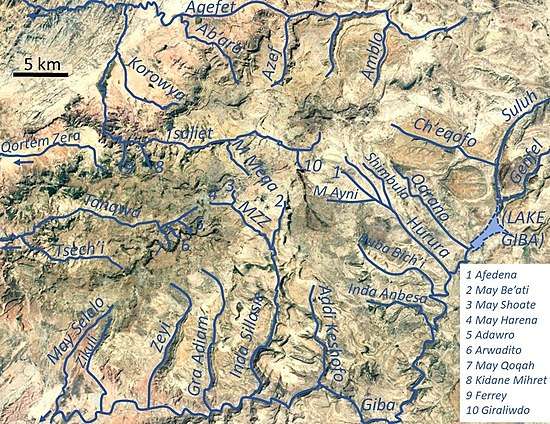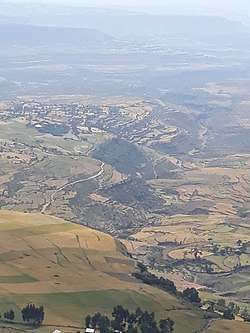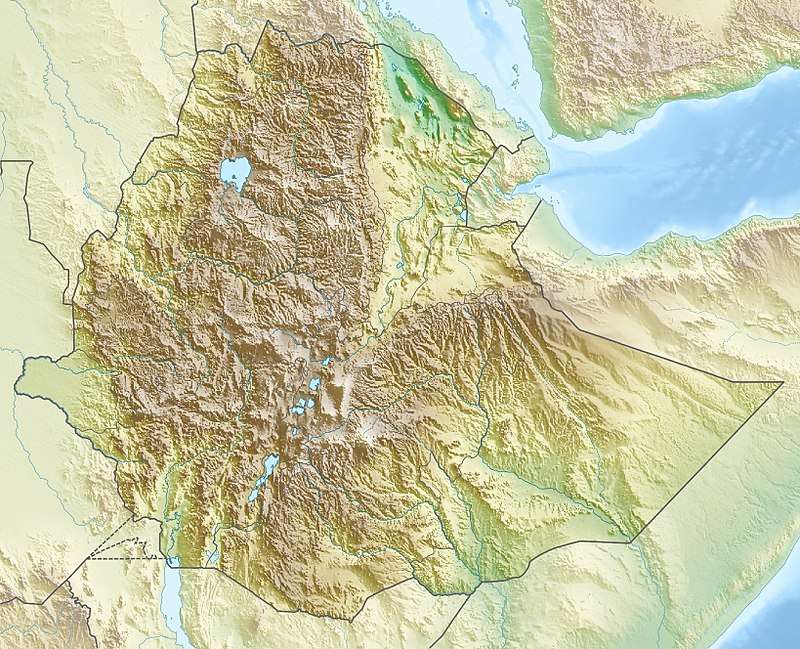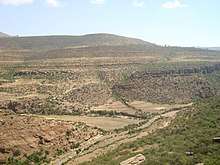May Zegzeg
May Zegzeg is a river of the Nile basin. Rising in the mountains of Dogu’a Tembien in northern Ethiopia, it flows southward to empty finally in Giba and Tekezé River.[1]

| May Zegzeg | |
|---|---|
 The May Zegzeg gorge at Hech'i | |
 May Zegzeg River in Dogu’a Tembien | |
| Etymology | Cascading water in Tigrinya |
| Location | |
| Country | Ethiopia |
| Region | Tigray Region |
| District (woreda) | Dogu’a Tembien |
| Physical characteristics | |
| Source | May Sho'ate |
| • location | Harena in Mika'el Abiy municipality |
| • elevation | 2,270 m (7,450 ft) |
| 2nd source | May Harena |
| • location | Harena in Mika'el Abiy municipality |
| Mouth | Rubaksa River |
• location | Rubaksa |
• coordinates | 13.614°N 39.226°E |
• elevation | 1,970 m (6,460 ft) |
| Length | 7 km (4.3 mi) |
| Width | |
| • average | 25 m (82 ft) |
| Basin features | |
| River system | Permanent river |
| Landmarks | Inda Meru’e lapiez |
| Waterfalls | Several small waterfalls |
| Topography | Mountains and deep gorges |
Characteristics
It is a confined river, locally meandering in its narrow alluvial plain, with an average slope gradient of 43 metres per kilometre. With its tributaries May Sho'ate and May Harena, the river has cut a gorge.[2] Jointly with adjacent May Be’ati River, this river is the source of Rubaksa River.

Flash floods and flood buffering
Runoff mostly happens in the form of high runoff discharge events that occur in a very short period (called flash floods). These are related to the steep topography, often little vegetation cover and intense convective rainfall. The peaks of such flash floods have often a 50 to 100 times larger discharge than the preceding baseflow.[2] The magnitude of floods in this river has however been decreased due to interventions in the catchment. At Habdi Luqmuts and on other steep slopes, exclosures have been established; the dense vegetation largely contributes to enhanced infiltration, less flooding and better baseflow.[3] Physical conservation structures such as stone bunds[4][5] and check dams also intercept runoff.[6][7]
Boulders and pebbles in the river bed
Boulders and pebbles encountered in the river bed can originate from any location higher up in the catchment, including the following lithological units:[8]
May Zegzeg Integrated Catchment Management Project
As part of outreach accompanying research in Dogu'a Tembien, the May Zegzeg Integrated Catchment Management Project was set up in 2004 in the catchment of the May Zegzeg River by researchers in cooperation with ADCS, a local NGO. The project included the implementation of conservation techniques to increase water infiltration and conserve the soil. The objective was to improve the livelihood of the communities of Harena, Hech'i and Addi Qolqwal as well as to demonstrate and promote global catchment management in the district.[10] The results of the implementation of site-specific conservation techniques aimed at increasing water infiltration and conserving soil were particularly monitored in the headwaters at May Sho'ate: dry masonry stone bunds,[11] check dams in gullies,[12] and the set-aside of degraded rangelands which resulted in exclosures.[13]
Natural boundary
Over its full course, this river constitutes the border between[1] Mika'el Abiy (at the west) and Ayninbirkekin municipalities (at the east)
Trekking along the river
Trekking routes have been established across and along this river.[14] The tracks are not marked on the ground but can be followed using downloaded .GPX files.[15]
- Trek 12, runs parallel to the river on the eastern bank, from May Sho'ate to Rubaksa
In the rainy season, flash floods may occur and it is advised not to follow the river bed. [16]
See also
- List of Ethiopian rivers
References
- Jacob, M. and colleagues (2019). Geo-trekking map of Dogu'a Tembien (1:50,000). In: Geo-trekking in Ethiopia's Tropical Mountains - The Dogu'a Tembien District. SpringerNature. ISBN 978-3-030-04954-6.
- Amanuel Zenebe, and colleagues (2019). The Giba, Tanqwa and Tsaliet rivers in the headwaters of the Tekezze basin. In: Geo-trekking in Ethiopia's Tropical Mountains - The Dogu'a Tembien District. SpringerNature. doi:10.1007/978-3-030-04955-3_14. ISBN 978-3-030-04954-6.
- Descheemaeker, K. and colleagues (2006). "Runoff on slopes with restoring vegetation: A case study from the Tigray highlands, Ethiopia". Journal of Hydrology. 331 (1–2): 219–241. doi:10.1016/j.still.2006.07.011.
- Nyssen, Jan; Poesen, Jean; Gebremichael, Desta; Vancampenhout, Karen; d'Aes, Margo; Yihdego, Gebremedhin; Govers, Gerard; Leirs, Herwig; Moeyersons, Jan; Naudts, Jozef; Haregeweyn, Nigussie; Haile, Mitiku; Deckers, Jozef (2007). "Interdisciplinary on-site evaluation of stone bunds to control soil erosion on cropland in Northern Ethiopia". Soil and Tillage Research. 94 (1): 151–163. doi:10.1016/j.still.2006.07.011. hdl:1854/LU-378900.
- Gebeyehu Taye and colleagues (2015). "Evolution of the effectiveness of stone bunds and trenches in reducing runoff and soil loss in the semi-arid Ethiopian highlands". Zeitschrift für Geomorphologie. 59 (4): 477–493. doi:10.1127/zfg/2015/0166.
- Nyssen, J.; Veyret-Picot, M.; Poesen, J.; Moeyersons, J.; Haile, Mitiku; Deckers, J.; Govers, G. (2004). "The effectiveness of loose rock check dams for gully control in Tigray, Northern Ethiopia". Soil Use and Management. 20: 55–64. doi:10.1111/j.1475-2743.2004.tb00337.x.
- Etefa Guyassa and colleagues (2017). "Effects of check dams on runoff characteristics along gully reaches, the case of Northern Ethiopia". Journal of Hydrology. 545 (1): 299–309. doi:10.1016/j.jhydrol.2016.12.019.
- Sembroni, A.; Molin, P.; Dramis, F. (2019). Regional geology of the Dogu'a Tembien massif. In: Geo-trekking in Ethiopia's Tropical Mountains — The Dogu'a Tembien District. SpringerNature. ISBN 978-3-030-04954-6.
- Moeyersons, J. and colleagues (2006). "Age and backfill/overfill stratigraphy of two tufa dams, Tigray Highlands, Ethiopia: Evidence for Late Pleistocene and Holocene wet conditions". Palaeogeography, Palaeoclimatology, Palaeoecology. 230 (1–2): 162–178. Bibcode:2006PPP...230..165M. doi:10.1016/j.palaeo.2005.07.013.
- Reubens, B. and colleagues (2019). Research-based development projects in Dogu’a Tembien. In: Geo-trekking in Ethiopia's Tropical Mountains - The Dogu'a Tembien District. SpringerNature. ISBN 978-3-030-04954-6.
- Nyssen, Jan; Poesen, Jean; Gebremichael, Desta; Vancampenhout, Karen; d'Aes, Margo; Yihdego, Gebremedhin; Govers, Gerard; Leirs, Herwig; Moeyersons, Jan; Naudts, Jozef; Haregeweyn, Nigussie; Haile, Mitiku; Deckers, Jozef (2007). "Interdisciplinary on-site evaluation of stone bunds to control soil erosion on cropland in Northern Ethiopia". Soil and Tillage Research. 94 (1): 151–163. doi:10.1016/j.still.2006.07.011. hdl:1854/LU-378900.
- Nyssen, J.; Veyret-Picot, M.; Poesen, J.; Moeyersons, J.; Haile, Mitiku; Deckers, J.; Govers, G. (2004). "The effectiveness of loose rock check dams for gully control in Tigray, Northern Ethiopia". Soil Use and Management. 20: 55–64. doi:10.1111/j.1475-2743.2004.tb00337.x.
- Descheemaeker, K. and colleagues (2006). "Sediment deposition and pedogenesis in exclosures in the Tigray Highlands, Ethiopia". Geoderma. 132 (3–4): 291–314. doi:10.1016/j.geoderma.2005.04.027.
- Description of trekking routes in Dogu'a Tembien. In: Geo-trekking in Ethiopia's Tropical Mountains - The Dogu'a Tembien District. SpringerNature. 2019. ISBN 978-3-030-04954-6.
- https://www.openstreetmap.org/traces/tag/nyssen-jacob-frankl
- Nyssen, Jan (2019). "Logistics for the Trekker in a Rural Mountain District of Northern Ethiopia". Geo-trekking in Ethiopia's Tropical Mountains. GeoGuide. Springer-Nature. pp. 537–556. doi:10.1007/978-3-030-04955-3_37. ISBN 978-3-030-04954-6.